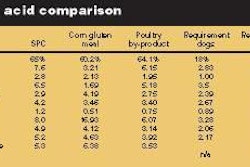.png?auto=format%2Ccompress&q=70&w=400)
"Several petfood companies are now looking at how dogs respond genetically to a particular diet. They do so by profiling genes that are turned on and off in response to the diet in question." That's according to Keith E. Murphy, PhD who spoke at Petfood Forum 2007 on the topic, "The impact of genetics and genomics on research concerning palatability."
Murphy is professor of genetics, pathobiology and biotechnology at Texas A&M University, College Station, Texas, USA. His laboratory studies the domestic dog with the goal of improving the dog's health and quality of life via increased understanding of canine genetics. His research also serves as models for study of certain human hereditary diseases as well as aging in humans.
Smelling is believing
"For the dog, palatability is about smell," says Murphy. "Several studies have shown taste plays very little role in the choice of food for the dog. The dog enjoys food through its olfactory sense, which is deeply rooted in its basic genetic composition."
The National Institutes of Health (NIH) has a large program that studies taste and olfaction. In 2004, NIH spent US$55 million to sequence the canine genome.
Thus we now know every chromosome in the dog and what genes are on what chromosomes.
"We are able to start dissecting any trait we wish," notes Murphy. "We are starting to understand the genetic basis for complex behaviors such as olfaction and taste." This is of critical importance to pharmaceutical companies and petfood companies, because compliance is much better if their therapeutic products are palatable.
As for cats, Murphy points out that our understanding of feline genetics lags behind that of the dog, but there has been progress. In August 2006, several labs studying feline genetics presented papers at the third international conference on "Advances in canine and feline genomics and inherited diseases," at the University of California Davis.
Genomic technology
"Genomic technology enables less invasive and more informative research that may some day result in petfoods formulated for specific genotypes," according to Kelly S. Swanson, PhD, assistant professor of animal and nutritional sciences at the University of Illinois. Genomics is the branch of genetics that studies organisms in terms of their genomes (their full DNA nucleotide sequences).
Functional genomics, the study of assessing gene function, is of major importance. If applied correctly, nutritional genomics will enhance our understanding of metabolic pathways and aid in maximizing the nutritional and health status of the dog and cat.
Gene expression profiling also may aid in efficacy and toxicity testing of functional ingredients that have become very popular in petfoods. Mechanisms of action, optimal inclusion levels and toxicological effects of most functional ingredients are not completely understood, especially in dogs and cats.
Pharmaceutical companies already are heavily involved in the development of genotype-specific products for precise treatment of disease. However, if genotype-specific diets are formulated that result in decreased incidence of disease, pharmaceutical use can be minimized. Populations with the most to gain from the development of genotype-specific diets are those highly susceptible to disease or those already diagnosed with a disease.
"These tools," says Swanson, "will be important in determining nutrient requirements, testing novel ingredients and developing nutritional therapies used to prevent and treat diseases."
New tools
"Genomic tools have provided extensive information about the DNA sequences that encode odor, taste and irritant receptors," according to Nancy E. Rawson, PhD, at the Monell Chemical Senses Center. We now have tools to identify and characterize the molecular binding sites in the receptor proteins responsible for sweet, bitter and meaty (umami) sensationsbasic tastes sensed by specialized receptor cells on the human tongue.
Expressing these receptor proteins in high throughput assay systems permits screening candidate flavors in much the same way pharmaceutical companies screen for active pharmaceuticals. Yet this approach has proven far more challenging than expected and few commercial applications have been forthcoming.
Based on studies of evolutionary genetics, it now appears that chemosensory receptor genes evolved to be more susceptible to mutation than other types of physiologically important genes. This feature would be an advantage to the species as it would increase the ability of the population to detect and discriminate a wider variety of chemicals in their environment. The more information available to use in learning friend from foe, food from toxin, potential mate from relative, the more likely the population is to survive in a changing environment.
Ultimately, it may be possible to design petfoods targeting the taste/odor perceptual abilities of individual breeds. In view of the evolutionary importance of chemosensory ability, it is likely that there will be significant breed differences in flavor perception that will become more pronounced over successive generations.
These tools will permit the design of flavor chemicals that improve palatability by evoking, enhancing or blocking particular qualities.

















